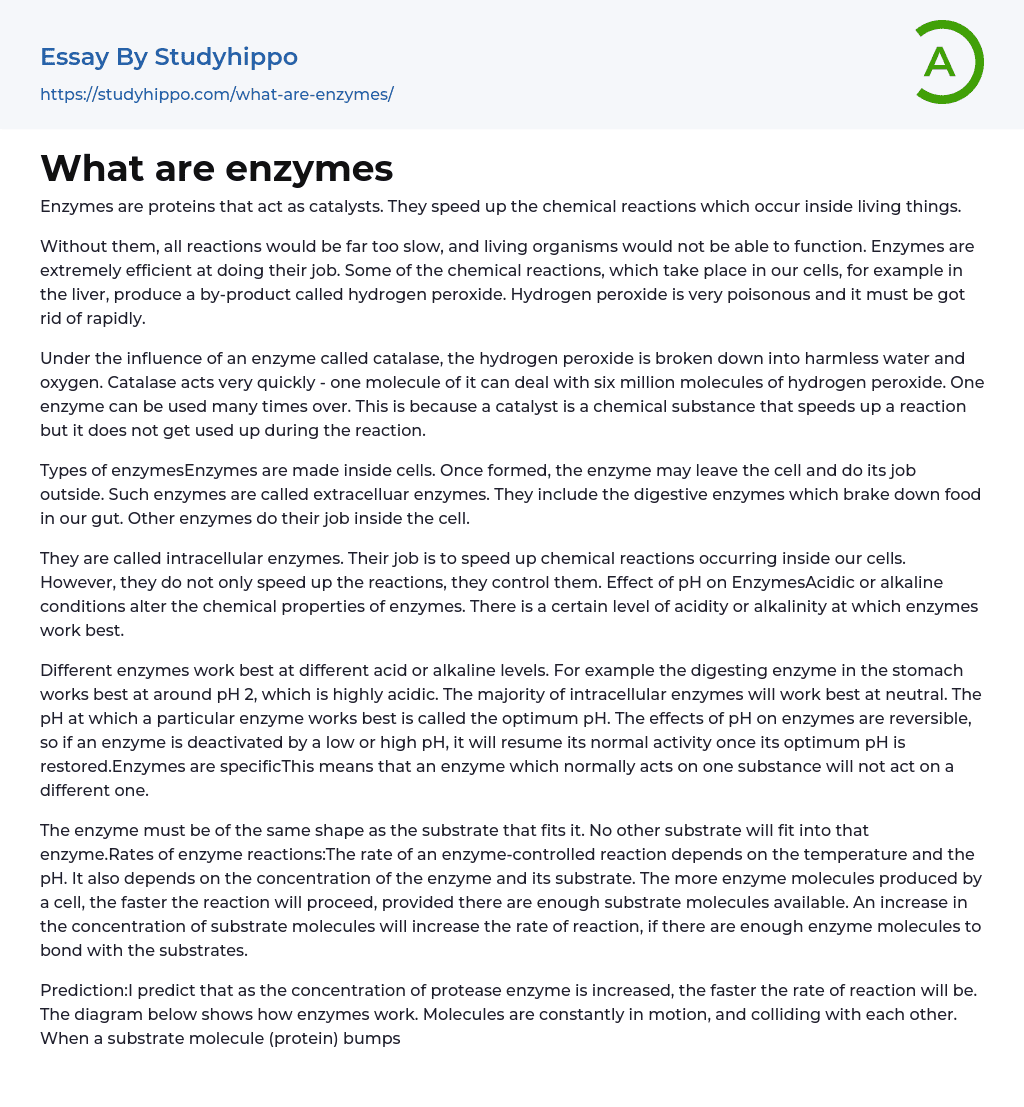Enzymes are proteins that act as catalysts. They speed up the chemical reactions which occur inside living things.
Without them, all reactions would be far too slow, and living organisms would not be able to function. Enzymes are extremely efficient at doing their job. Some of the chemical reactions, which take place in our cells, for example in the liver, produce a by-product called hydrogen peroxide. Hydrogen peroxide is very poisonous and it must be got rid of rapidly.
Under the influence of an enzyme called catalase, the hydrogen peroxide is broken down into harmless water and oxygen. Catalase acts very quickly - one molecule of it can deal with six million molecules of hydrogen peroxide. One enzyme can be used many times over. This is because a catalyst is a chemical substance that speeds up a reaction but it
...does not get used up during the reaction.
Types of enzymesEnzymes are made inside cells. Once formed, the enzyme may leave the cell and do its job outside. Such enzymes are called extracelluar enzymes. They include the digestive enzymes which brake down food in our gut. Other enzymes do their job inside the cell.
They are called intracellular enzymes. Their job is to speed up chemical reactions occurring inside our cells. However, they do not only speed up the reactions, they control them. Effect of pH on EnzymesAcidic or alkaline conditions alter the chemical properties of enzymes. There is a certain level of acidity or alkalinity at which enzymes work best.
Different enzymes work best at different acid or alkaline levels. For example the digesting enzyme in the stomach works best at around pH 2, which i
highly acidic. The majority of intracellular enzymes will work best at neutral. The pH at which a particular enzyme works best is called the optimum pH. The effects of pH on enzymes are reversible, so if an enzyme is deactivated by a low or high pH, it will resume its normal activity once its optimum pH is restored.Enzymes are specificThis means that an enzyme which normally acts on one substance will not act on a different one.
The enzyme must be of the same shape as the substrate that fits it. No other substrate will fit into that enzyme.Rates of enzyme reactions:The rate of an enzyme-controlled reaction depends on the temperature and the pH. It also depends on the concentration of the enzyme and its substrate. The more enzyme molecules produced by a cell, the faster the reaction will proceed, provided there are enough substrate molecules available. An increase in the concentration of substrate molecules will increase the rate of reaction, if there are enough enzyme molecules to bond with the substrates.
Prediction:I predict that as the concentration of protease enzyme is increased, the faster the rate of reaction will be. The diagram below shows how enzymes work. Molecules are constantly in motion, and colliding with each other. When a substrate molecule (protein) bumps into a molecule of the right enzyme, it fits into a depression on the surface of the enzyme molecule. This depression on the surface is called an active site.
The reaction then takes place and the molecules of product (amino acids) leave the active site, freeing it for another substrate molecule to enter. The active site of a particular enzyme has a
specific shape into which only one kind of substrate will fit. This substrate fits into the active site rather like a key fits into a lock. This is why enzymes are specific in their action.
When an enzyme is denatured by heat, the active site shape is changed, so the substrate molecules no longer fit into it.Predicted Diagram:The reason why I predict that as the concentration of enzyme goes up, the rate of reaction will go up is because, as the enzyme concentration increases, there are more protease enzymes present in the solution. This would result in a greater number of enzymes being able to break down the proteins into amino acids, and therefore gaining a higher volume. We can therefore see that if the concentration of enzyme is lower, the volume of amino acid produced will also be lower.
The reaction can only occur if there is an enzyme-substrate complex formed, e.g. a protein substrate binding with an enzyme molecule. It must be ensured that all other variables are kept constant, which greatly decreases the chance of inaccuracies, as these other variables would affect the rate of breaking down the protein.
If the concentration of enzyme was raised greatly, the reaction speed would not continue to increase, because there would be more active sites than substrates, and this would result in surplus enzymes, as there will already be enough enzymes to break down the protein substrates. This would mean that there will be a certain concentration of enzyme, which would give us the highest reaction speed, and even if the concentration were raised even more from this point, the reaction speed would not increase. I
predict that there will be positive correlation, to the extent that when the concentration is doubled, the rate of reaction is doubled. Therefore as double the amount of enzymes are introduced, double the amount of protein will be broken down, until the maximum capacity is reached.
- Acid essays
- Calcium essays
- Carbohydrate essays
- Carbon essays
- Chemical Bond essays
- Chemical Reaction essays
- Chemical reactions essays
- Chromatography essays
- Concentration essays
- Copper essays
- Diffusion essays
- Ethanol essays
- Hydrogen essays
- Organic Chemistry essays
- Osmosis essays
- Periodic Table essays
- Ph essays
- Salt essays
- Sodium essays
- Titration essays
- Bacteria essays
- Biotechnology essays
- Breeding essays
- Cell essays
- Cell Membrane essays
- Cystic Fibrosis essays
- Enzyme essays
- Human essays
- Microbiology essays
- Natural Selection essays
- Photosynthesis essays
- Plant essays
- Protein essays
- Stem Cell essays
- Viruses essays




